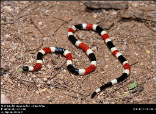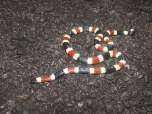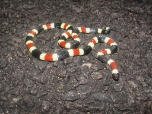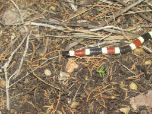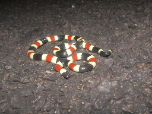Western Coral Snake (Micruroides euryxanthus)
Description: Adults of M. euryxanthus are 11–24 inches long. The color pattern consists of broad, alternating rings of red and black, separated by narrower rings of white or yellow. Markings become paler as they reach the belly. The head is black, the black extending to the posterior border of the parietals. The smooth dorsal scales are arranged in 15 rows at midbody. The ventrals number 214–241. The anal plate is divided. The subcaudals number 21–34, and are divided (paired). Micruroides euryxanthus resembles Micrurus fulvius. However, the white or yellow rings are broader than in M. fulvius, and there are fewer black rings on the tail, usually only 2. Also, the first ring on the body (the first ring behind the white or yellow ring on the back of the head) is red, whereas in Micrurus fulvius it is black.
Habitat: M. euryxanthus is found in arid and semiarid regions in numerous habitats, both on plains and on lower mountain slopes, from sea level to 5,800 feet. In Arizona it is abundant in rocky upland desert.
Range: Micruroides euryxanthus is found from central Arizona and southwestern New Mexico to Mazatlán in southern Sinaloa. Isolated populations are also found in the Chocolate Mountains, La Paz County, western Arizona and on Tiburón Island in the Gulf of California.
Found in these States:
AZ |
NV
Venom: The venom of M. euryxanthus is neurotoxic and extremely potent, but no fatalities have been reported.
Diet: The Arizona coral snake preys upon small snakes, predominantly Rena (snake), but also Sonora, and Tantilla. It will also eat small lizards such as skinks.
Reproduction: Like all other species of New World coral snakes (genera Leptomicrurus and Micrurus), Micruroides euryxanthus is oviparous. Adult females may lay up to 3 eggs, and each hatchlings is 7–8 inches in total length.
Status: Listed as Least Concern in view of its wide distribution, presumed large population, and because it is unlikely to be declining fast enough to qualify for listing in a more threatened category.
Subspecies: Three, with just one found in our region:
Sonoran Coral Snake - (Micruroides euryxanthus australis)
Arizona Coral Snake - (Micruroides euryxanthus euryxanthus)
Sinaloa Coral Snake - (Micruroides euryxanthus neglectus)
»» Kingdom: Animalia - Animals
»» Phylum: Chordata - Chordates
»» Subphylum: Vertebrata - Vertebrates
»» Class: Reptilia - Reptiles
»» Order: Squamata - Scaled Reptiles
»» Suborder: Serpentes
»» Superfamily: Elapoidea
»» Family: Eplaidae - Elapids
»» Genus: Micruroides
»» Species: Micruroides euryxanthus - Western Coral Snake
»» Subspecies:
»» Micruroides euryxanthus australis - Sonoran Coral Snake
»» Micruroides euryxanthus euryxanthus - Arizona Coral Snake
»» Micruroides euryxanthus neglectus - Sinaloa Coral Snake
This article uses material from the Wikipedia article "Micruroides", which is released under the Creative Commons Attribution-Share-Alike License 3.0. Content may have been omitted from the original, but no content has been changed or extended.
|




